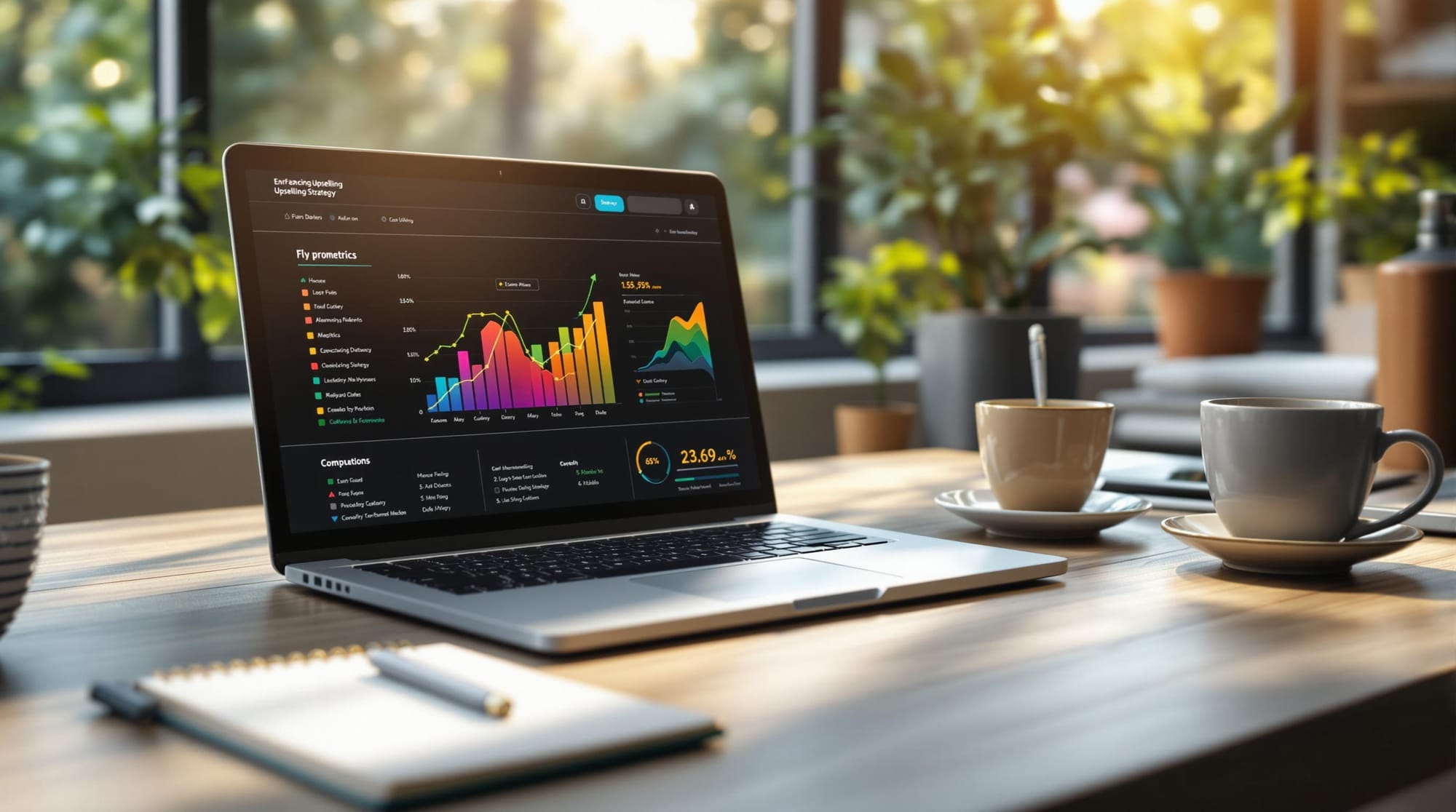5 Metrics to Measure Upsell Effectiveness
Learn the five essential metrics to evaluate and enhance your upselling strategies for improved revenue and customer satisfaction.

Want to know if your upselling strategies are working? Start tracking these 5 key metrics:
- Conversion Rate: Measures how many customers accept your upsell offers. A strong rate is 20-25%.
- Average Order Value (AOV): Tracks how much customers spend per transaction. Upsells can boost AOV significantly.
- Customer Lifetime Value (CLV): Shows total revenue a customer generates over time. Customers who accept upsells often have 30-50% higher CLV.
- Upsell Rate: Percentage of customers accepting upsells. A rate above 20% is a good benchmark.
- Return on Investment (ROI): Calculates the financial return of your upselling efforts. Helps assess profitability.
Quick Tip: Use analytics tools and personalized offers to improve these metrics and refine your upselling strategy. Keep reading for actionable insights and examples to optimize your approach.
Related video from YouTube
1. Conversion Rate
Conversion rate measures how many customers accept your upsell offers compared to the total number who see them. It’s a straightforward percentage: divide successful upsells by total offers made, then multiply by 100.
This metric is a key indicator of how well your upsell offers connect with your audience. For instance, a 20% conversion rate from an email campaign falls within the typical industry benchmark of 20-25% for strong performance .
To improve your conversion rate, focus on these factors:
- Relevance: Ensure the offer aligns with the customer’s needs and purchase history.
- Timing: Present the upsell at the right moment in the customer journey.
- Clarity: Clearly explain the benefits of upgrading.
- Pricing: Offer a compelling price-to-value balance.
Using analytics tools can help you track results, fine-tune your timing, and improve targeting. Keeping a close eye on this metric helps identify which strategies are working .
While conversion rate tells you how effective your upsell offers are, understanding their impact on overall revenue requires looking at another key metric: Average Order Value (AOV).
2. Average Order Value (AOV)
Average Order Value (AOV) measures how much customers spend on average per transaction. It's a helpful way to gauge the success of upselling strategies. To calculate AOV, divide total revenue by the number of orders. For example, if your revenue is $50,000 from 1,000 orders, your AOV would be $50.
Here's an example of how upselling can boost AOV. In this case, upselling adds $20,000 in revenue and increases AOV by 40%:
| Scenario | Orders | Revenue | AOV |
|---|---|---|---|
| Before Upsells | 1,000 | $50,000 | $50 |
| With Upsells | 1,000 | $70,000 | $70 |
| Impact | - | +$20,000 | +40% |
Monitoring AOV can reveal how well upselling works across different customer groups and campaigns. For instance, customers who accept upsell offers often have a lifetime value that’s 50% higher than those who don’t .
If you're looking to increase AOV through upselling, try these approaches:
- Personalized recommendations: Suggest products that complement what the customer is already buying.
- Strategic timing and pricing: Experiment with when and how you present offers to find what works best.
Break down your AOV data by customer type, product category, or sales channel to pinpoint which upselling strategies are most effective . While AOV focuses on individual transactions, combining it with metrics like Customer Lifetime Value (CLV) offers a fuller picture of your customer relationships.
3. Customer Lifetime Value (CLV)
Customer Lifetime Value (CLV) measures the total revenue a customer generates throughout their relationship with your business. Unlike metrics like Average Order Value (AOV), which focus on single transactions, CLV gives a bigger picture of how profitable a customer is over time.
Research shows that customers who accept upsell offers tend to have a 30% higher lifetime value compared to those who don’t . Here's a breakdown of how upsells can influence CLV:
| Customer Segment | Average CLV | Impact on Revenue |
|---|---|---|
| No Upsells Accepted | $500 | Baseline |
| Basic Upsells Accepted | $750 | +50% |
| Premium Upsells Accepted | $1,000 | +100% |
To evaluate how upsells impact CLV, consider these key factors:
- Purchase Frequency: If customers buy more often after an upsell, it’s a sign of increased loyalty.
- Retention Rate: Measure how long customers stay engaged after accepting upsells. A higher retention rate suggests your offers hold real value.
- AOV Trends: Look at how AOV changes for customers who accept upsells versus those who don’t.
To boost CLV, tailor your upsell offers based on individual customer preferences and purchase history .
While CLV highlights long-term profitability, don’t forget to track the upsell rate to understand the immediate effectiveness of your offers.
4. Upsell Rate
The upsell rate tracks the percentage of customers who accept additional offers. It’s a direct indicator of how well your upselling approach connects with your audience .
An upsell rate exceeding 20% is considered strong, while anything below 10% highlights areas that need improvement. Pairing this metric with Average Order Value (AOV) and Customer Lifetime Value (CLV) gives a clearer picture of how effective your upselling efforts are.
Here’s how you can boost your upsell rate:
- Offer Timing: Timing is key. Show upsell options when customers are most likely to act, like after they add a related item to their cart or during checkout.
- Relevance and Value: Make sure your upsell matches the customer’s original purchase intent. Whether it’s bulk discounts, premium features, or added functionality, clearly communicate the benefits. This approach not only increases acceptance but also leaves customers feeling satisfied .
For even better results, use data-driven personalization. By analyzing customer purchase history and behavior, you can craft tailored offers that appeal to specific segments. Personalized upsells often perform better than generic ones .
While the upsell rate measures how often customers respond to offers, you’ll need to evaluate Return on Investment (ROI) to understand the financial impact of your strategy.
5. Return on Investment (ROI)
ROI works hand-in-hand with metrics like conversion rate and average order value (AOV) to reveal the financial results of your upselling efforts. To calculate it, divide the net revenue generated from upsells by the campaign costs, then multiply by 100. For instance, if a campaign brings in $2,000 in revenue but costs $500, the ROI is 300% . This can help justify scaling up or investing further.
Key factors to consider when assessing ROI include:
- Costs related to campaign execution and tools
- Staff time and training expenses
- Revenue from immediate upsells
- Long-term gains from repeat customers
- Boost in average order value
To improve your ROI:
- Make sure to track attribution carefully to pinpoint which strategies yield the best results .
- Keep a close eye on all campaign-related expenses for accurate ROI calculations .
- Experiment with offer timing to get the best outcomes .
When you combine ROI insights with other metrics like conversion rate and upsell rate, you gain a clearer picture of how well your strategies are working. This data-driven approach can help fine-tune campaigns to maximize profits while keeping customers happy .
Continuously updating and refining your tactics ensures you're focusing on what works best for your business. By evaluating ROI alongside other metrics, you can sharpen your upselling strategies and drive steady growth.
Using Tools to Improve Upsell Strategies
E-commerce platforms today come with advanced tools designed to make upselling more effective and easier to track. These tools help streamline the upselling process while keeping a close eye on key performance metrics.
Personalized Offers with AI
AI tools analyze customer behavior and purchase history to create tailored upsell offers. This approach allows businesses to adjust their strategies based on actual customer data, leading to better results.
Testing and Refining Offers
A/B testing has become a must for fine-tuning upsell strategies. With modern tools, businesses can experiment with timing, incentives, and messaging to find the combinations that work best for boosting metrics like conversion rates and average order value (AOV).
Smart Offer Timing
Automation tools take the guesswork out of upselling by presenting offers at the right time. For example, they can display upsell options when a customer is close to meeting a free shipping threshold, helping to increase AOV while improving conversion rates through well-timed suggestions.
Real-Time Performance Monitoring
Upsell tools now integrate seamlessly with analytics platforms, making it easy to track important metrics as they happen. Here's a breakdown of what these tools can monitor:
| Metric | What It Tracks |
|---|---|
| Conversion Rate | Tracks how many customers accept offers |
| AOV | Monitors changes in cart value |
| CLV | Follows long-term customer purchases |
| ROI | Calculates revenue vs. costs |
Customizable Options
The best tools allow businesses to customize upsell offers to fit their brand. Features like multilanguage support, brand-specific designs, and flexible offer setups ensure a smooth customer experience while reducing cart abandonment.
When choosing tools for upselling, look for options that combine detailed metric tracking with a seamless shopping experience. The goal is to improve performance without disrupting the customer journey.
Conclusion
To build better upselling strategies, businesses should pay close attention to metrics like conversion rates, AOV (Average Order Value), CLV (Customer Lifetime Value), upsell rates, and ROI. These numbers help shape strategies that boost revenue while keeping customers happy.
The best upselling strategies rely on finding the right balance: increasing revenue without compromising customer satisfaction. By analyzing data, businesses can fine-tune their offers and target the right audience more effectively.
E-commerce tools make it easier to track upselling performance and adjust strategies on the fly. These tools not only measure how well campaigns are doing but also help businesses craft offers that align with customer needs and expectations.
For long-term success, it’s crucial to keep an eye on these metrics while focusing on delivering real value to customers. Understanding what works and what doesn’t allows businesses to improve their offers and strengthen customer relationships.
As customer preferences shift and markets change, staying flexible and using data to guide decisions ensures upselling efforts remain profitable and relevant. A data-driven approach keeps businesses ahead of the curve, optimizing revenue while meeting customer expectations.
FAQs
What is the upsell rate?
The upsell rate represents the percentage of customers who accept additional offers. To calculate it, divide the number of customers who accepted upsells by the total number of offers made, then multiply by 100. For instance, if 200 out of 1,000 customers accept an upsell, your upsell rate is 20%.
A strong upsell rate indicates that your offers resonate well with your customers and that your strategies are working effectively.
How to track upselling?
Tracking upselling involves monitoring key metrics such as conversion rate, AOV (Average Order Value), CLV (Customer Lifetime Value), ROI (Return on Investment), and expansion MRR (Monthly Recurring Revenue). Analytics tools can provide real-time insights into these metrics. Here's a breakdown:
| Metric | What It Measures | Why It Matters |
|---|---|---|
| Conversion Rate | Percentage of customers accepting offers | Evaluates how compelling your upsell offers are |
| Average Order Value (AOV) | Average amount spent per transaction | Indicates growth in transaction value |
| Customer Lifetime Value (CLV) | Total revenue generated by a customer | Highlights long-term customer profitability |
| Return on Investment (ROI) | Revenue compared to investment | Assesses the profitability of upsell campaigns |
| Expansion MRR | Recurring revenue from upsells | Tracks additional revenue from existing customers |
Modern analytics tools, often integrated with e-commerce platforms, can pinpoint:
- Which upsell offers perform best
- The ideal timing for presenting offers
- Customer segments most likely to respond
- Products that drive the highest upsell success
